Crypto payment channel: Why has it become a superconductor of traditional payments?

Reprinted from panewslab
02/14/2025·3MAs time goes by 2025, blockchain has gradually built a financial payment ecosystem parallel to the traditional financial system. The crypto payment channel has already carried a stablecoin volume of 200 billion and a stablecoin transaction volume of 5.62 trillion US dollars in 2024. This is Visa's adjusted data, which is more suitable for payment itself. It is almost the annual transaction volume of Mastercard. . According to the report of ARK Invest of Mutoujie's statistical caliber, in 2024, the annualized transaction volume of stablecoins will reach US$15.6 trillion, about 119% and 200% of Visa and Mastercard respectively.
In any case, the popularity and large-scale adoption of crypto payments are already an indisputable fact, especially the case of Stripe's acquisition of stablecoin service provider Bridge for US$1.1 billion . As Stripe CEO Patrick Collison said , crypto payment channels are superconductors of payment. They form the basis of a parallel financial system that provides faster settlement times, lower fees, and the ability to operate seamlessly across borders. This idea took a decade to mature, but today we see hundreds of companies working to make it a reality. Over the next decade, we will see crypto channels becoming the core of financial innovation and driving global economic growth.
There are many more things to solve, like what Boss Kevin listed:
-
transaction market: $16 trillion
-
trade finance: $89 trillion
-
remittance $4 trillion prefund
-
The average international transfer rate is close to 7%
-
3-5 Business day credit
-
1.4 billion people have no bank account
Then, this time, the compilation of this article by Dmitriy Berenzon Cryptorails: Superconductors for Payments is a very overall view of traditional payments, and how the crypto payment path based on blockchain can bring benefits to traditional payment paths, and It provides multiple real application scenarios and future predictions, which are worth reading in depth. Here, enjoy:
Author: Dmitriy BerenzonPartner@archetypevc
When Satoshi Nakamoto released Bitcoin in 2009, he envisioned using an encrypted network to make payments so that payments can flow freely on the Internet like information. While this direction was correct, the technology, economic models and ecosystems at that time were not suitable for commercializing this use case.
Fast forward to 2025, and we witnessed the convergence of several important innovations and developments that make this vision inevitable: Stablecoins have been widely adopted by consumers and businesses, market makers and OTC counters are now It is easy to hold stablecoins on the balance sheet, DeFi applications have created a strong on-chain financial infrastructure, with a large amount of inbound and outbound monetary acceptances around the world, faster and cheaper block space, and simplified embedded wallets The user experience is a clearer regulatory framework that reduces uncertainty.
Now, we have the opportunity to build a new generation of payment companies and leverage the power of "crypto channels" to achieve better unit economic benefits than traditional financial payment systems, which are subject to multiple rent-seeking intermediaries and outdated infrastructure . These cryptographic channels are forming the backbone of a parallel financial system that operates 24/7 in real time and is essentially global.
In this article, Dmitriy Berenzon will:
-
Explain the key components of the traditional financial system;
-
Overview of current key use cases for encryption channels;
-
Discuss the obstacles and challenges of continuing adoption;
-
Share your forecast for the market outlook in five years.
To further inspire this article, it is worth noting that there are a lot more companies running here than you think – as of this writing, there are about 280 companies:
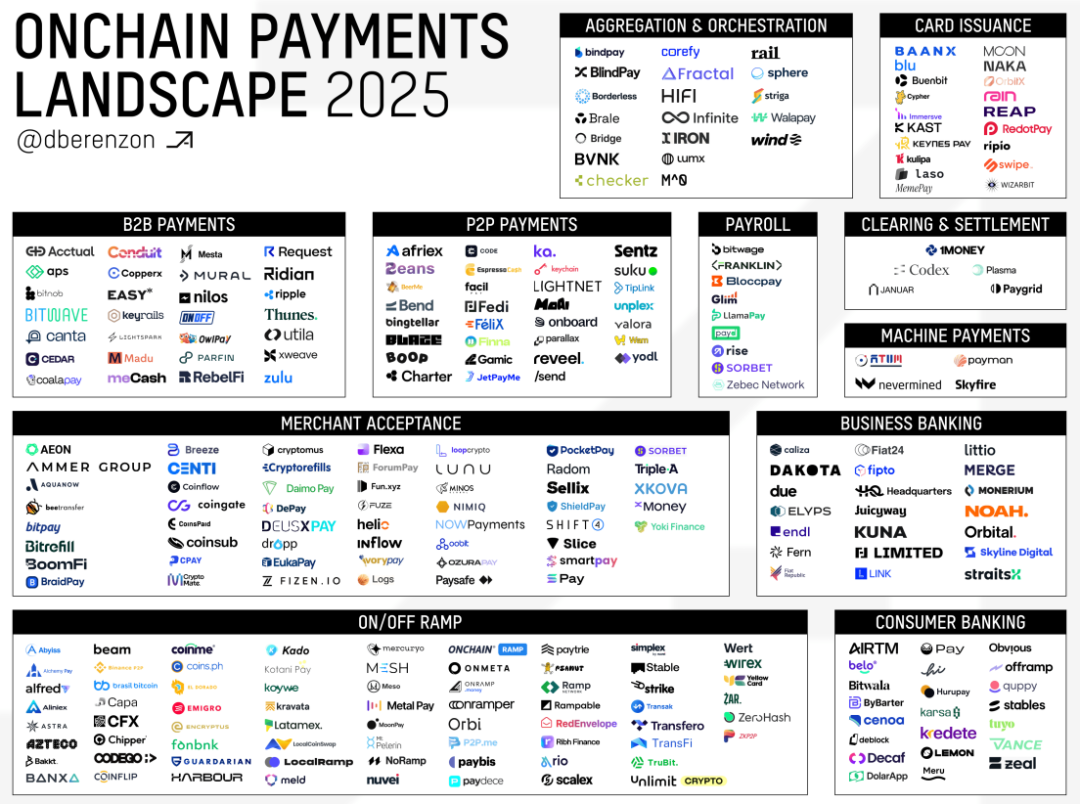
1. Existing payment channels
To understand the importance of crypto channels, it is first necessary to understand the key concepts of existing payment channels and the complex market structure and system architecture in which they operate. If you are already familiar with these, feel free to skip this section.
1.1 Card Networks
Although the topology of credit card organization networks is complex, the main players in credit card transactions have not changed over the past 70 years. Essentially, credit card payment involves four major players:
1. Merchant;
2. Cardholder;
3. Issuing the bank;
4. Acquisition bank;
The first two are simple, but the last two are worth explaining.
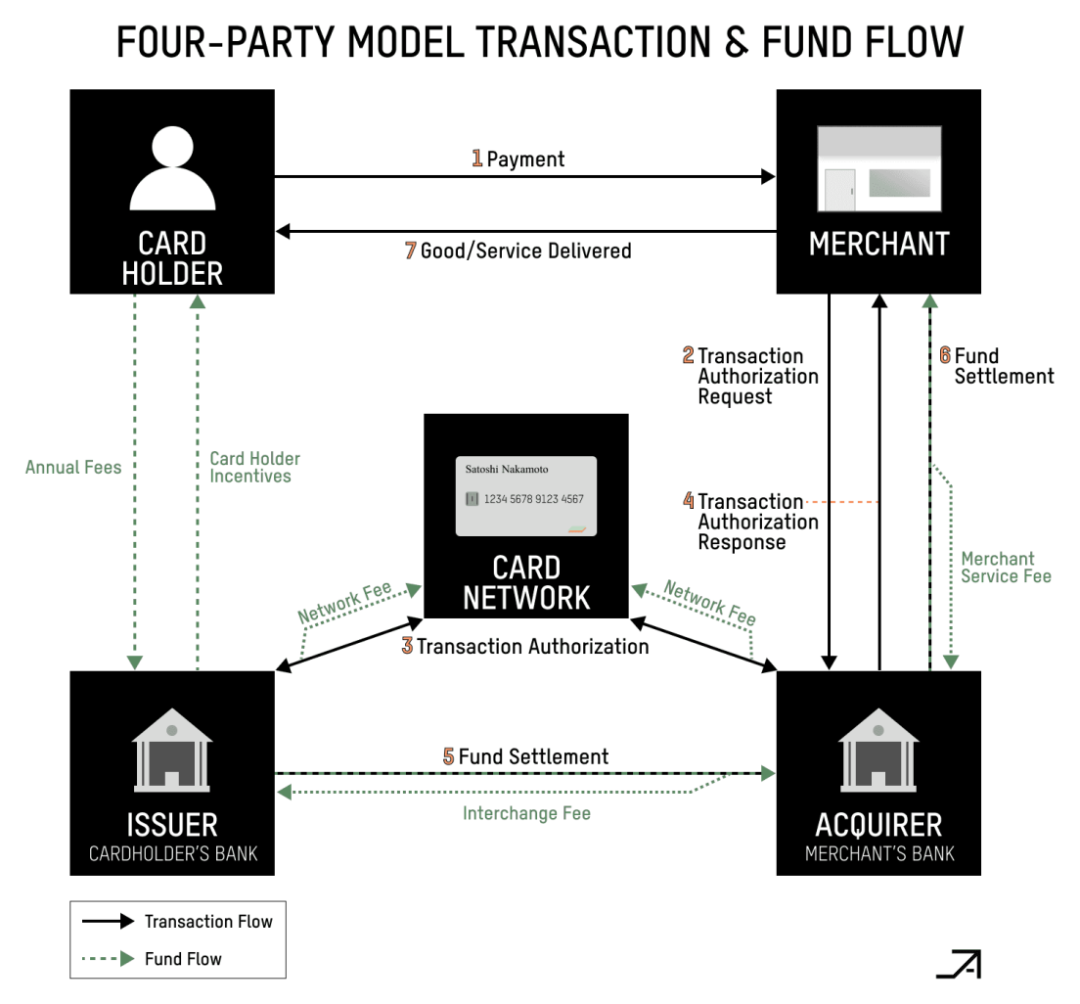
The issuing bank or issuing agency provides credit or debit cards to customers and authorizes transactions. When a transaction request is made, the issuing bank will decide whether to approve by checking the cardholder's account balance, available credit limit and other factors. Credit cards are essentially borrowing funds from the issuing agency, while debit cards transfer money directly from your account.
If a merchant wants to accept credit card payments, they need an Acquirer (can be a bank, payment processor, gateway or independent sales organization) that is an authorized member of the credit card organization network. The term acquiring agency stems from its role in collecting payments on behalf of the merchant and ensuring that these funds arrive at the merchant’s account.
The credit card organization network itself provides channels and rules for credit card payments. They connect the acquiring agency with the issuing bank, provide clearing functions, formulate participation rules, and determine transaction fees. ISO 8583 remains the main international standard, which defines how credit card payment information (such as authorization, settlement, refund) is constructed and exchanged among network participants. In an online environment, card issuing agencies and acquiring agencies are like their distributors. The card issuing agencies are responsible for handing over more cards to users, while the acquiring agencies are responsible for handing over as many card terminals and payment gateways as possible to the merchant. in hand so that they can accept credit card payments.
In addition, there are two types of credit card organization networks: "open loop" and "closed loop". Open-loop networks like Visa and Mastercard involve multiple parties: issuing banks, acquiring banks and the credit card organization network itself. Credit card organization networks promote communications and transaction routing, but are more like a market that relies on financial institutions to issue credit cards and manage customer accounts. Only banks are allowed to issue credit cards for open-loop networks. Each debit or credit card has a bank identification code (BIN) provided by Visa to the bank, while non-bank entities like PayFacs require a "BIN sponsor" to issue a credit card or process transactions.
In contrast, closed-loop networks like American Express are self-sufficient, with a company handling all aspects of the transaction process – they usually issue their own cards, are their own banks, and provide their own merchant acquiring services. The general consideration is that closed-loop systems provide more control and better profits, but at the cost of more limited merchant acceptance. Instead, open-loop systems offer wider adoption at the cost of controlling and sharing of benefits of the participants.
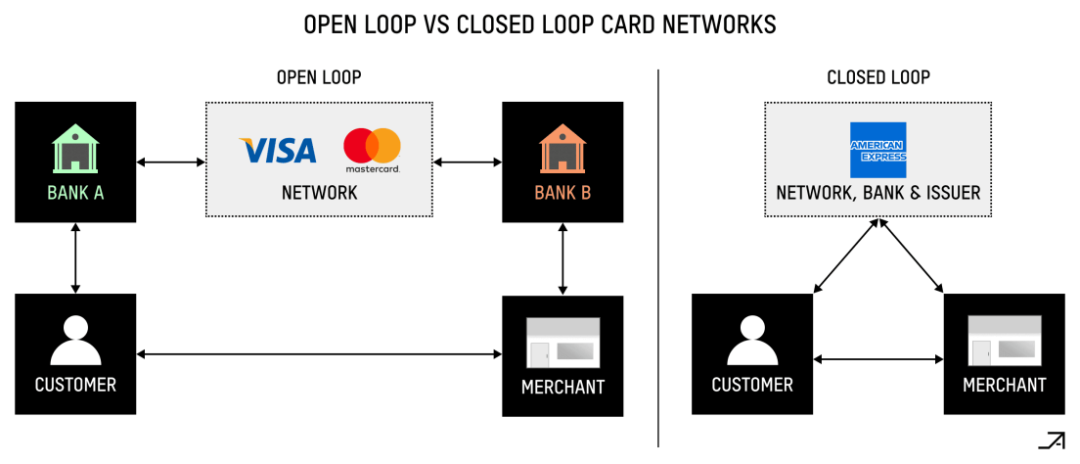
Source: Arvy
The economics of payment are very complex, and there are multiple layers of fees in the network. Interchange Fees are part of the payment fees charged by the issuing bank to provide access to its customers. Although technically, the acquiring bank directly pays the exchange fee, the cost is usually passed on to the merchant. Card organization networks usually set exchange fees, which usually account for the majority of the total payment costs. These fees vary widely across regions and transaction types. For example, in the United States, consumer credit card fees range from ~1.2% to ~3%, while in the European Union, the upper limit is 0.3%. In addition, the deck fee (Scheme Fees) is also determined by the card organization network, which compensates the network to connect the acquiring agency and the issuing bank, and acts as a "channel" to ensure the accurate flow of transactions and capital flows. There are also settlement fees (Settlement Fees) to be paid to the acquiring agency, usually the transaction settlement amount or percentage of the transaction volume.
While these are the most important players in the value chain, the reality is that today’s market structure is much more complex in practice:
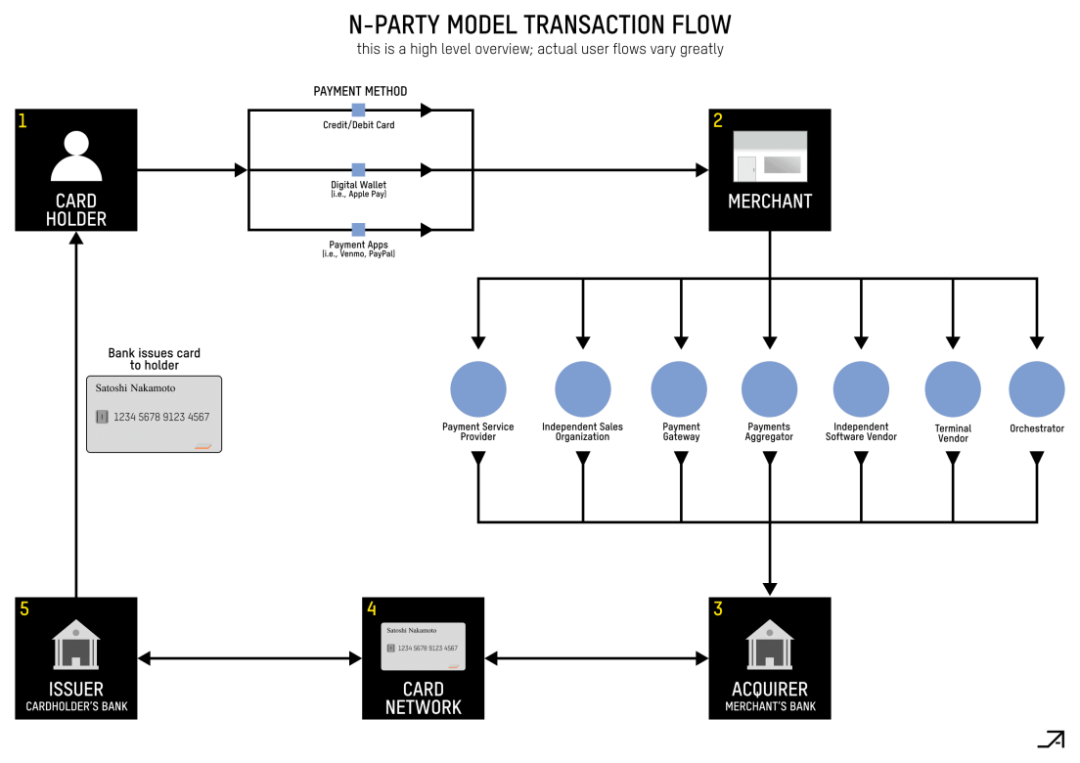
Source: 22nd
In the above link, there are several important players:
Payment Gateway encrypts and transmits payment information, connects payment processors and acquisition agencies to authorize, and conveys transaction approval or rejection to the company in real time.
Payment Processor processes payments on behalf of the acquiring bank. It forwards transaction details from the gateway to the acquiring bank, which then communicates with the issuing bank through the card organization network to obtain authorization. The payment processor receives the authorization response and sends it back to the gateway to complete the transaction. It also handles settlement, the process in which funds actually enter the merchant’s bank account. Typically, a business sends a batch of authorized transactions to a payment processor, which submits these transactions to acquiring banks to initiate a transfer of funds from the issuing bank to the merchant’s account.
Payment Facilitator or Payment Service Provider was first launched by PayPal and Square around 2010, like a small payment processor between merchants and acquisition banks. It effectively acts as an aggregator by bundling many smaller merchants into their systems to achieve economies of scale and simplifies operations by managing fund flows, processing transactions and ensuring payments. PayFacs holds the direct merchant ID of the card organization network and assumes responsibilities for onboarding, compliance (such as the Anti-Money Laundering Act) and underwriting on behalf of the merchants they work with.
Orchestration Platform is a middleware technology layer that simplifies and optimizes merchants' payment processes. It connects to multiple processors, gateways and acquisition agencies through a single API, and improves transaction success, reduces costs and improves performance by routing payments based on factors such as location or fees.
1.2 Automated Clearing House
Automatic Clearing House (ACH) is one of the largest payment networks in the United States and is actually owned by the banks that use it. It was originally founded in the 1970s, but it really became popular when the U.S. government started using it to send social security funds, which encouraged banks across the country to join the network. Today, it is widely used in payroll processing, bill payments and B2B transactions.
There are two main types of ACH transactions: remittance and withdrawal. When a user receives a salary or pays bills online using a bank account, the user is using the ACH network. The process involves multiple participants: the company or individual who initiated the payment (the sponsor), their bank (ODFI), the receiving bank (RDFI), and the operator acting as all of these transactions. In the ACH process, the promoter submits the transaction to the ODFI, and the ODFI sends the transaction to the ACH operator, and the ACH operator switches the transaction to the RDFI. At the end of each day, the operator calculates the total net settlement for its member banks (the Federal Reserve is responsible for managing the actual settlement).

Source: US Payment System: Guide to Payment Professionals
One of the most important things about ACH is how it handles risks. When a company initiates an ACH payment, its bank (ODFI) is responsible for ensuring everything is legal. This is especially important for withdrawals – imagine if someone uses your bank account information without permission. To prevent this from happening, regulations allow disputes within 60 days of receipt of the statement, while companies such as PayPal have developed clever verification methods such as conducting small test deposits to confirm account ownership.
ACH systems have been working hard to meet modern needs. In 2015, they launched the "Same-Day ACH" to process payments faster. Nevertheless, it still relies on batch processing rather than real-time transfer and has limitations. For example, you cannot send more than $25,000 in a single transaction, and it does not apply to international payments.
1.3 Wire Transfer (Wire)
Wire transfers are at the heart of high-value payment processing, and the two main systems in the United States are Fedwire and CHIPS. These systems process time-critical, secure payments that require immediate settlement, such as securities transactions, major commercial transactions and real estate purchases. Once executed, wire transfers are usually irrevocable and may not be cancelled or revoked without the consent of the payee. Unlike conventional payment networks that process transactions in batches, modern wire transfers use Real-Time Gross Settlement (RTGS), which means that each transaction is settled separately when it occurs. This is an important feature because the system processes hundreds of billions of dollars a day, and the risk of intraday bank failure using traditional net settlements is too high.
Fedwire is an RTGS system that allows participating financial institutions to send and receive same-day transfers of funds. When a business initiates a wire transfer, its bank verifies the request, deducts money from the account and sends a message to Fedwire. The Federal Reserve then immediately deducts the money from the sending bank's account and credits it to the receiving bank's account, and the receiving bank will then credit it to the final payee's account. The system operates from 9 p.m. the previous day to 7 p.m. ET, and is closed during weekends and federal holidays.
Owned by large U.S. banks through clearing houses, CHIPS is an alternative to the private sector, but is smaller and serves only a few large banks. Unlike Fedwire's RTGS approach, CHIPS is a Netting Settlement system, which means that the system allows multiple payments between the same pair. For example, if Alice wants to send $10 million to Bob and Bob wants to send $2 million to Alice, CHIPS will combine those payments into a $8 million payment Bob pays to Alice. While this means that CHIPS payments take longer than real-time transactions, most payments are still settled within the day.
As a complement to these systems, SWIFT is not actually a payment system, but a global information network for financial institutions. It is a member-owned cooperative organization whose shareholders represent over 11,000 member organizations. SWIFT enables banks and securities companies around the world to exchange secure structured information, many of which initiate payment transactions across a variety of networks. According to Statrys, SWIFT transfer takes about 18 hours to complete.
In a general process, the sender of the fund instructs its bank to send a wire transfer to the recipient. The following value chain is a simple situation where two banks belong to the same wire transfer network.

Source: US Payment System: Guide to Payment Professionals
In more complex situations, especially cross-border payments, transactions need to be performed through a Correspondent Banking Relationship, which is usually used to coordinate payments.
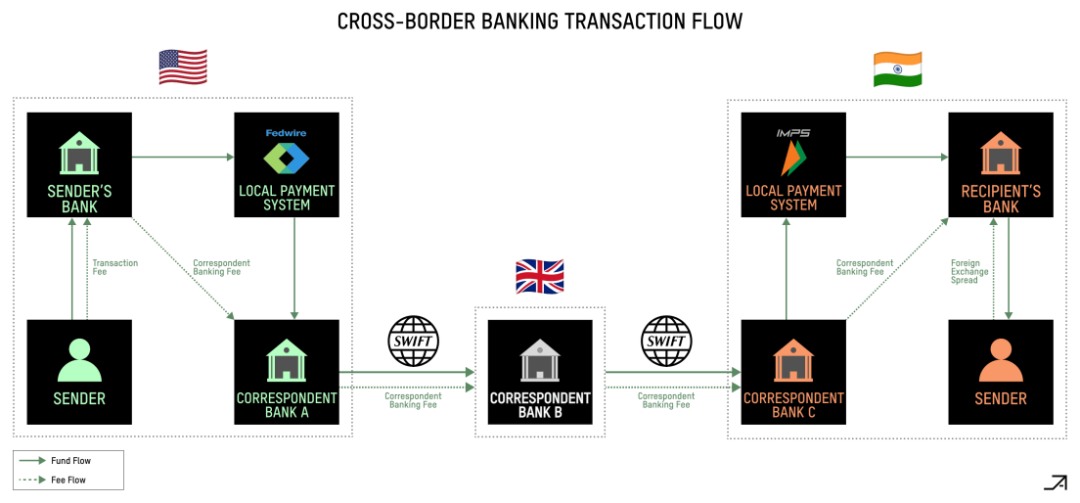
Source: Matt Brown
2. Practical use cases
Now that we have a basic understanding of traditional payment channels, we can pay attention to the advantages of crypto payment channels.
Crypto payment channels are most effective when traditional US dollar usage is limited but demand for US dollar is strong. Think about places where the dollar needs to preserve its value or serve as a banking alternative but cannot easily obtain traditional dollar bank accounts, countries that are usually economically unstable, high inflation, currency controls or underdeveloped banking systems, such as Argentina, Venezuela, Nigeria , Turkey and Ukraine. Furthermore, one can say that the US dollar is a better store of value than most other currencies, and consumers and businesses usually choose the US dollar because the US dollar can be easily used as a medium of exchange or converted to local at the point of sale Legal currency.
The advantages of encrypted payment channels are also most obvious in the scenario of globalization of payments, because blockchain networks are not restricted by national borders and rely on existing Internet connections to provide global coverage. According to the World Bank, there are currently 92 RTGS systems operating worldwide, each system usually owned by its own central bank. While they are ideal for handling domestic payments in these countries, the problem is that they cannot “communicate with each other.” Crypto payment channels can act as a binder between these different systems, or they can be extended to countries without them.
Crypto payments are also particularly suitable for payments with a certain degree of urgency or a high usual time preference. This includes cross-border supplier payments and foreign aid payments. This is also helpful in scenarios where agency banking networks are particularly inefficient. For example, despite its close geographical location, sending money from Mexico to the United States is actually more difficult than sending money from Hong Kong to the United States. Even in developed corridors such as the United States to Europe, payments usually require through four or more agency banks.
On the other hand, crypto payment channels are less attractive to domestic transactions in developed countries, especially where credit card usage is high or real-time payment systems already exist. For example, European intra-income payments went smoothly through SEPA, while the stability of the euro eliminated the need for alternatives denominated in USD.
2.1 Merchant Acceptance
Merchant acquiring orders can be divided into two different use cases: front-end integration and back-end integration. In the front-end approach, merchants can directly accept cryptocurrency as a payment method for customers. While this is one of the oldest use cases, historically it hasn't seen much transaction volume, as few people hold cryptocurrencies, and even fewer want to spend it, and for those who hold For those with cryptocurrencies, there are limited options to use. The market today is different as more and more people hold crypto assets (including stablecoins), more and more merchants accept them as payment options as it enables them to reach new customer bases and ultimately Sell more goods and services.
From a geographical point of view, most of the transaction volume comes from businesses selling products to consumers in early adopters countries of cryptocurrency, which are often emerging markets such as China, Vietnam and India. From a merchant perspective, most of the demand comes from online gambling and retail stock brokers that want to reach emerging markets, Web2 and Web3 markets (such as watch suppliers and content creators), and real money games (such as fantasy sports and sweepstakes) ) user.
The "front-end" merchant acceptance process is usually as follows:
1. PSP usually creates wallets for merchants after KYC/KYB;
2. The user sends the cryptocurrency to the PSP;
3. PSP converts cryptocurrencies into fiat currencies through liquidity providers or stablecoin issuers and sends funds to the merchant’s local bank account, which may use other licensed partners.
The main challenge that prevents this use case from continuing to be adopted is psychological, as cryptocurrencies don’t seem “real” to many. There are two major user roles that need to be solved: one does not care about its value at all and hopes to regard everything as a magical Internet currency; the other is pragmatic, depositing funds directly into the bank.
In addition, in the United States, it will be more difficult for consumers to use crypto payments, because credit card rewards are actually paying consumers a 1% to 5% rebate for shopping. There have been attempts to convince merchants to promote crypto payments directly to consumers as an alternative payment method for credit cards, but so far, they have not succeeded. While lowering the exchange rate is a good idea for merchants, it is not a problem for consumers. Merchant Customer Exchange launched in 2012 and failed in 2016 for the reason that was exactly what they could not start the consumer side that adopted the flywheel. In other words, it is difficult for merchants to directly incentivize users from credit card payments to crypto asset payments, because payments are already "free" to consumers, so the value proposition should be addressed first at the consumer level.
In the backend approach, crypto payment can provide merchants with faster settlement time and fund acquisition channels. Settlement of Visa and Mastercard may take 2-3 days, American Express takes 5 days, and international settlement takes longer, for example, about 30 days in Brazil. In some use cases, such as Uber, merchants may need to inject capital into their bank accounts in advance to make payments before settlement.
Instead, people can effectively enter the crypto payment channel through the user's credit card, transfer funds on the chain, and eventually transfer funds directly into the merchant's bank account in local currency. In addition to improving working capital due to the reduced maturity of funds occupied in the payment path, merchants can further improve their funding management by freely and instantly converting between digital dollars and earning assets such as tokenized U.S. Treasuries. .
More specifically, the "backend" merchant acceptance process may look like this:
1. Users enter their credit card information to complete the transaction;
2. PSP creates a wallet for the customer and provides funds to the wallet through the entrance to accept traditional payment methods;
3. Buy USDC with a credit card transaction and then send it from the customer's wallet to the merchant's wallet;
4. PSP can choose to transfer to the merchant’s bank account through local railway T+0 (i.e. the same day);
5. PSP usually receives funds from the acquiring bank at T+1 or T+2 (i.e. within 1-2 days).
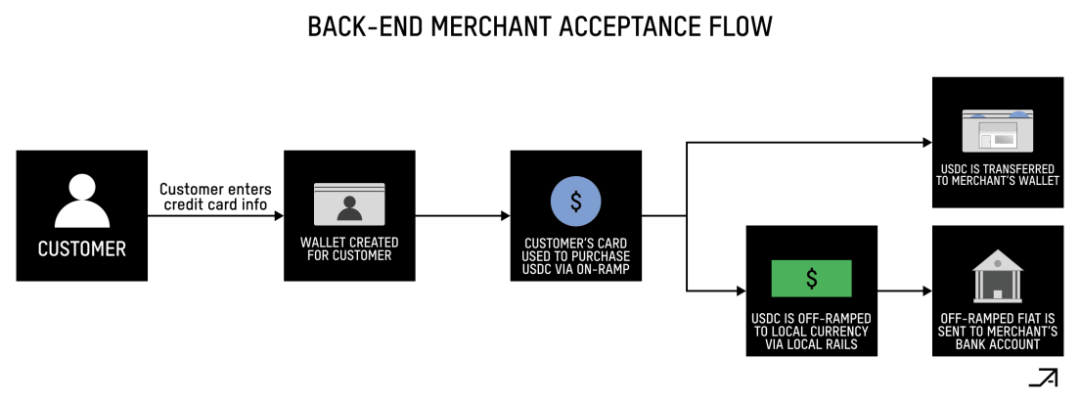
2.2 Debit Cards
The ability to link debit cards directly to unmanaged smart contract wallets creates an unexpectedly powerful bridge between the block space and the real world, driving the organic adoption of different user roles. In emerging markets, these cards are becoming the main consumer tools, increasingly replacing traditional banks. Interestingly, even in countries where currency is stable, consumers are using these cards to gradually accumulate dollar savings while avoiding foreign exchange (FX) fees when purchasing. High net worth individuals are also increasingly using these cryptocurrency-pegged debit cards as effective tools for consuming USDCs worldwide.
The advantage of debit cards over credit cards is due to two factors: debit cards face fewer regulatory restrictions (e.g., MCC 6051 was completely rejected in Pakistan and Bangladesh, where capital controls are strictly controlled), and the risk of fraud on debit cards is low , because refunds for settled crypto transactions can bring serious liability issues to credit cards.
In the long run, cards tied to crypto wallets for mobile payments may actually be the best way to combat fraud, as there is biometric verification on your phone: scan your face, spend, and top up from your bank account Go to the wallet.
2.3 Remittance
Remittance refers to the act of those who migrate abroad to remit funds from their working countries to their home country. According to the World Bank, the total remittances in 2023 are approximately US$656 billion, equivalent to Belgium's GDP.
The cost of traditional remittance systems is high, resulting in less money in the pockets of collectors. On average, the cost of cross-border remittances is 6.4% of the amount, but these costs vary widely – the cost from Malaysia to India is 2.2% (for large traffic channels such as US to India, the fee is even lower) , the cost of remittance from Turkey to Bulgaria is as high as 47.6%. Banks tend to have the highest fees, around 12%, while remittance operators such as MoneyGram have an average fee of 5.5%.
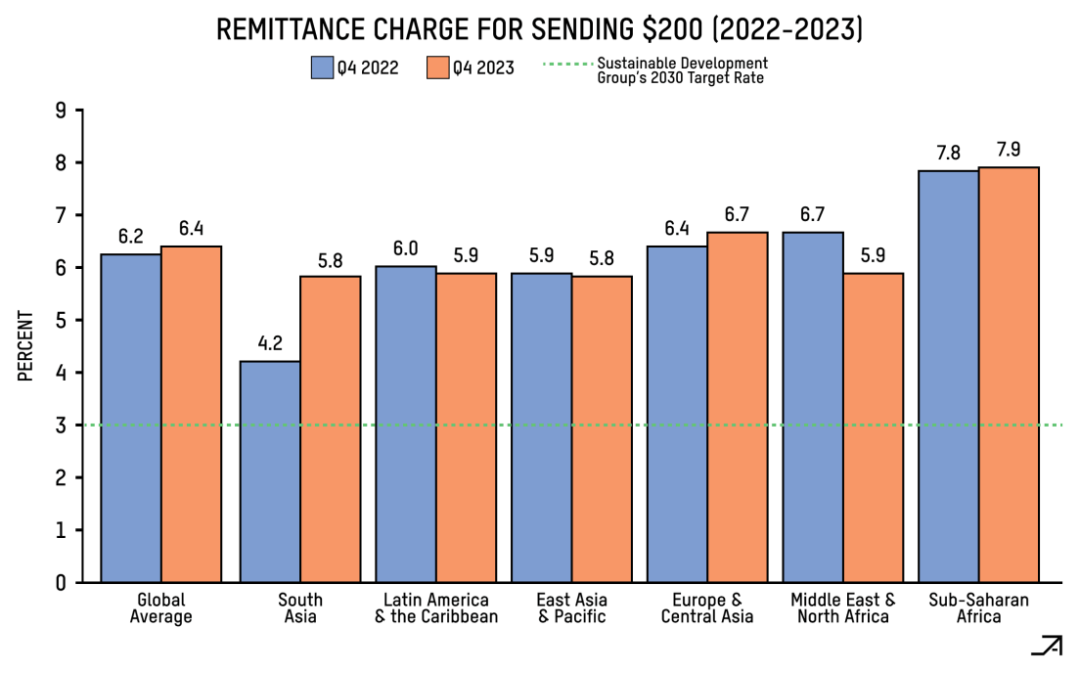
Source: World Bank
Crypto payments can provide a faster and cheaper way to remit money overseas, and the number of such companies depends largely on the size of the broader remittance market, with the largest channels of transaction volumes from the United States to Latin America (particularly Mexico, Argentina and Brazil), the United States to India and the United States to the Philippines. An important factor driving this trend is the unmanaged embedded wallets, which provide users with a Web2-level user experience.
The process of using crypto payments for remittance payments may look like this:
1. The sender enters the PSP through a bank account, debit card, credit card or directly to the on-chain address; if the sender does not have a wallet, one will be created for them;
2. PSP converts USDT/USDC to the local currency of the payee, which can be converted directly or through market makers or OTC partners;
3. PSP pays fiat currency to the payee's bank account, which can be paid directly from their comprehensive bank account, or through a local payment gateway; or PSP can first generate a non-custodial wallet for the payee to collect it. funds and give them the option to keep it on the chain;
4. In many cases, the payee needs to complete the KYC first before receiving the funds.
Despite this, the marketing path for crypto remittance projects is still difficult. One problem is that you usually need to inspire people to leave from remittance operators, which can be expensive. Another problem is that transfers on most Web2 payment applications are already free, so local transfers alone are not enough to overcome the network effects of existing applications. Finally, while the on-chain transfer component works well, you still need to interact with traditional banking institutions on the "last mile", so users may end up with the same or worse problems due to inbound and exit currency acceptance costs and frictions. . In particular, payment gateways that convert to local fiat currency and pay in customized ways such as mobile phones or self-service terminals will occupy the largest profit margin.
2.4 B2B Payments
Cross-Border (XB) B2B payment is one of the most promising applications of crypto payments because traditional payment systems are inefficient. Payments through the agency banking system can take weeks to settle, and in some extreme cases even longer — one founder said it took them 2.5 months to send supplier payments from Africa to Asia. To give another example, cross-border payments from Ghana to Nigeria (two neighboring countries) can take weeks and transfer fees are as high as 10%.
In addition, cross-border settlement is both slow and expensive for PSPs. For companies like Stripe that make payments, it can take up to a week to pay international merchants, and they have to lock in funds to deal with fraud and refund risks. Shortening the conversion cycle will release a large amount of working capital.
XB B2B payments are able to make significant progress on crypto channels, mainly because merchants care more about fees than consumers. A 0.5% to 1% reduction in transaction costs doesn’t sound like a lot, but when the transaction volume is large, especially for companies with meager profits, the fee is quite considerable. In addition, speed is also important. Complete payments within a few hours rather than days or weeks have a significant impact on the company's working capital. Additionally, businesses are more tolerant of worse user experiences and more complex experiences than consumers who expect a smooth out-of-the-box experience.
In addition, the cross-border payment market is huge - estimates from different sources vary greatly, but according to McKinsey data, the cross-border payment market revenue in 2022 is about US$240 billion and transaction volume is about US$150 trillion. Having said that, building a sustainable business is still difficult. While the "stable currency sandwich" -converting local currency into stablecoins and then converting it back - is certainly faster, it is also expensive, because conducting in and out of money on both sides will erode profits and will usually lead to uneconomies of unit economy continued. While some companies are trying to solve this problem by establishing internal market making departments, it is very balance sheet-consuming and difficult to scale. In addition, the customer base is relatively slow, worrying about regulation and risks, and often requires a lot of education.
That being said, forex costs could drop rapidly over the next two years as stablecoin legislation opens the door for more businesses to hold and operate digital dollars. As more inbound and outbound currency acceptance and token issuers will have direct banking relationships, they will be able to effectively provide internet-scale wholesale acceptance rates.
2.4.1 XB Supplier Payments
For B2B payments, most of cross-border transactions are made by importers for suppliers, usually in the United States, Latin America or Europe, and in Africa or Asia. Local payment channels in these countries are underdeveloped and it is difficult to find local bank partners. Crypto payments can also help alleviate pain points in specific countries. For example, in Brazil, you cannot use traditional payment channels to pay millions of dollars, making it difficult for businesses to make international payments. Some well-known companies, such as SpaceX, are already using crypto payments to achieve this use case.
2.4.2 XB Receivables
Businesses with global customers often find it difficult to collect funds in a timely and efficient manner. They usually work with multiple PSPs to collect funds locally, but require a quick way to collect payments, which can take days or even weeks, depending on the country. Crypto payments are faster than SWIFT transfers and can compress time to T+0.
Here is an example of the payment process for Brazilian companies to purchase goods from German companies:
1. The buyer sends Real to PSP through PIX;
2. PSP converts Real to USD, and then converts to USDC;
3. PSP sends USDC to the seller's wallet;
4. If the seller wants local fiat currency, the PSP will send USDC to the market maker or trading counter to convert it to local currency;
5. If the seller has a license/bank account, the PSP can send money to the seller through the local payment channel, and if not, the local partner can be used.
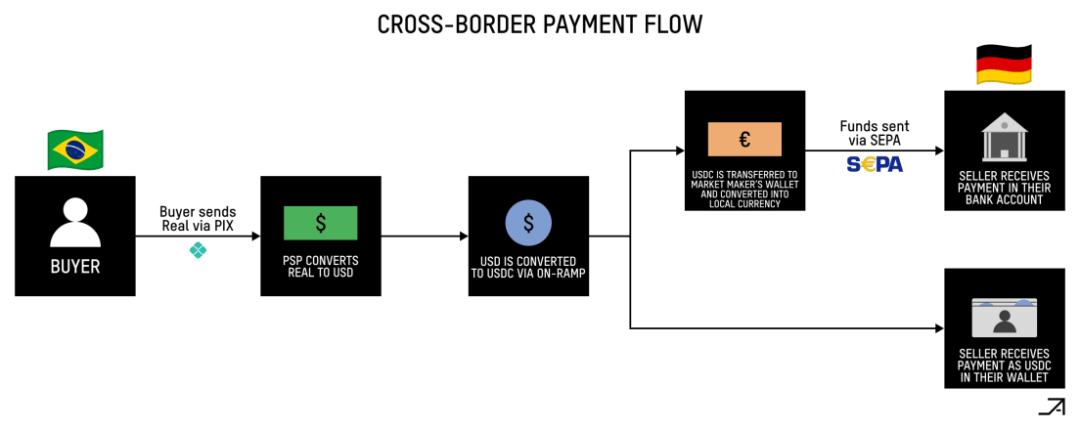
2.4.3 Financial Operations (Treasury Operations)
Companies can also use crypto payment channels to improve financial operations and accelerate global expansion. They can hold dollar balances and use local inbound and outgoing currency acceptance channels to reduce foreign exchange risks and enter new markets faster, even if local banks are reluctant to support them. They can also use crypto payment channels as an internal means of reorganizing and repatriating funds between countries where they operate.
2.4.4 Foreign Aid Disbursement
Another common use case we see for B2B is time-critical payments for which these crypto channels can be used to reach the payee faster. An example is foreign aid payments—allowing NGOs to use crypto payment channels to remit money to local export agents that can individually make payments to eligible individuals. This is especially effective in economies where the local financial system and/or government is very weak. For example, in countries like South Sudan, central banks have collapsed and local payments may take more than a month. But as long as you have a mobile phone and internet connection, there is a way to bring digital currency into the country, and individuals can convert digital currency into fiat currency, and vice versa.
The payment process for this use case might look like this:
1. NGOs provide funding to PSPs;
2. PSP sends bank transfers to OTC partners;
3. OTC partners convert fiat currency to USDC and send it to the local partner's wallet;
4. Local partners obtain USDC through peer-to-peer (P2P) traders.
2.5 Payroll
From a consumer perspective, one of the most promising early adopters is freelancers and contractors, especially in emerging markets. The value proposition of these users is that more money will end up in their pockets rather than going to intermediaries, and that money can be digital dollars. This use case also brings cost-effectiveness to the other party sending large-scale payments, and is especially useful for cryptocurrency native companies (such as exchanges) that already hold most of their funds in the form of cryptocurrencies.
The contractor's payment process is usually as follows:
1. The company conducts KYB/KYC with PSP;
2. The company sends US dollars to the PSP or USDC to the wallet address bound to the contractor;
3. The contractor may decide whether to keep it as cryptocurrency or withdraw it to a bank account, and the PSP usually enters some master service agreement with one or more off-site partners who hold relevant licenses within their respective jurisdictions to conduct Pay locally.
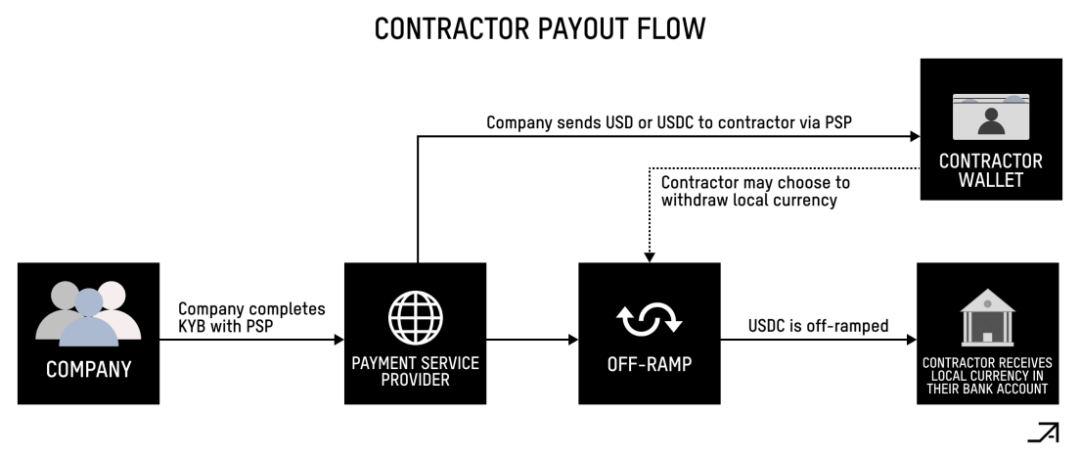
2.6 Inlet and Exit Money Acceptance (On/Off-ramps)
Inbound and exit money acceptance is a highly competitive and crowded market. While many early attempts have failed to scale, the market has matured over the past few years, with many companies operating sustainably and providing local payment channels worldwide. While inbound and outbound monetary acceptances can be used as standalone products (such as simply buying crypto assets), they can be arguably the most critical part of the payment process for bundled services (such as payment).
Building an inbound and outbound currency acceptance usually consists of three parts: obtaining the necessary license (such as VASP, MTL, MSB), ensuring that local banking partners or PSPs have access to local payment channels, and connecting market makers or OTC counters for liquidity .
Initially, exchanges were the dominant players in the market, but nowadays, more and more liquidity providers, from small forex and over-the-counter counters to large trading companies like Cumberland and FalconX, are offering access to markets. These companies can usually handle up to $100 million in transaction volume per day, so they are unlikely to run out of liquidity of popular assets. Some teams may even prefer them because they can promise spreads, which helps control margins.
Due to licensing, liquidity, and orchestration complexity, the non-U.S. portion of inbound and outbound currency acceptance is often much more difficult than the US portion. This is especially true in Latin America and Africa, where dozens of currencies and payment methods are available. For example, you can use PDAX in the Philippines because it is the largest cryptocurrency exchange there, but in Kenya you need to use several local partners like Clixpesa, Fronbank and Pritium based on payment methods.
The P2P channel relies on a network of “agents” – local individuals, currency providers, and small businesses such as supermarkets and pharmacies – who provide fiat and stablecoin liquidity. These agents are particularly common in Africa, where many people already operate mobile currency stalls for services like MPesa, and their main motivation is economic incentives – they make money through transaction fees and forex spreads. In fact, it is more profitable for individuals in high-inflation economies such as Venezuela and Nigeria to become agents than traditional service jobs such as taxi drivers or meal delivery. They can also work from home on their phones, usually only need a bank account and mobile currency to start working. What makes this system particularly powerful is that it can support dozens of local payment methods without formal permission or integration, as the transfer occurs between personal bank accounts.
It is worth noting that the foreign exchange rate of the P2P channel is usually more competitive. For example, Sudan’s Khartoum banks usually charge up to 25% foreign exchange fees, while local cryptocurrency P2P ramps provide 8% to 9%, which is actually the market exchange rate, not the bank mandatory exchange rate. Similarly, the P2P channel is able to provide a foreign exchange rate of about 7% cheaper than the bank exchange rate of Ghana and Venezuela. Generally, in countries with a large US dollar supply, interest rate spreads are smaller. In addition, the best markets for P2P channels are those with high inflation, high smartphone penetration, weak ownership rights, and unclear regulatory guidelines, as financial institutions do not have access to cryptocurrencies, which creates an environment for the booming self-custodial and P2P .
The payment process of the P2P portal may be as follows:
1. The user can choose or automatically specify a counterparty or "agent" that already owns USDT, which is usually hosted by the P2P platform;
2. The user sends legal currency to the agent through the local payment channel;
3. The agent confirms receipt and sends the USDT to the user.
From a market structure perspective, most inbound and outbound currency acceptances are commoditized and customer loyalty is low because they usually choose the cheapest option. To remain competitive, local payment channels may need to expand coverage, optimize for the most popular channels, and find the best local partners. In the long run, we may see each country integrating into several inbound and outbound monetary acceptance channels, each with a comprehensive license that supports all local payment methods and provides maximum liquidity. In the medium term, aggregators will be particularly useful because local providers are generally faster and cheaper, while combination options will often provide consumers with the best price and completion rate. If they can effectively optimize and route payments for hundreds of partners and routes, they may also suffer from minimal commodification. This also applies to orchestration platforms, including value-added services such as compliance, PSP selection, bank partner selection, and card issuance.
From a consumer’s perspective, the good news is that fees may tend to zero. We've seen this on Coinbase today, and the cost of converting from USD instant to USDC is $0. In the long run, most stablecoin issuers may provide such services to large wallets and fintech companies, further reducing fees.
3. Compliance and regulatory licensing
Obtaining a regulatory license is a painful but necessary step to expanding the scope of crypto payment applications. For startups, there are two ways: partner with an already licensed entity or obtain a license independently. Working with licensed partners can allow startups to bypass the high costs and long time they have to be licensed, but at the cost of lower profit margins, as a large portion of revenue goes to licensed partners. Alternatively, startups can choose to invest upfront (possibly hundreds of thousands to millions of dollars) to obtain licenses independently. While the road usually takes months or even years (one project says they took 2 years), it enables startups to deliver more comprehensive products directly to users.
While there are established options for obtaining regulatory licenses in many jurisdictions, achieving global licensing coverage is extremely challenging and even impossible, as each region has its own unique currency transfer regulations and you need more than 100 Only one license can cover the world. For example, in the United States alone, a project requires a currency transfer license (MTL) in each state, a BitLicense in New York, and a Money Services Business (MSB) registration with the Financial Crime Enforcement Network. Just getting MTL in all states can cost $500,000 to $2 million, and it can take up to a year. Overseas, the requirements are equally dazzling. Importantly, startups that are not custodial and do not touch the flow of funds can often bypass instant licensing requirements and enter the market faster.
4. Challenge
The popularity of payment methods is often difficult because it is a question of whether chickens or eggs come first. Either letting consumers adopt a payment method widely, which will force merchants to accept it or letting merchants use a specific payment method, which will force consumers to adopt it. For example, before Uber became popular in 2012, credit cards were a niche market in Latin America; everyone wanted a credit card because it allowed them to use Uber, which was safer than taxis, and (initially) more Cheap. This has made other on-demand applications like Rappi popular because people now have smartphones and credit cards. This has formed a virtuous cycle, and more and more people want credit cards because there are more cool apps that require credit card payments.
This also applies to mainstream consumers' adoption of crypto payments. We haven't seen the use cases where using stablecoins to pay is particularly favorable or completely necessary, although debit cards and remittance apps are bringing us closer to that moment. If the P2P app can unlock a completely new online behavior, it has a chance—and micropayments and creator payments seem to be exciting candidates. This is generally applicable to general consumer applications and will not be adopted without step-by-step functional improvements to the status quo.
There are still some problems in terms of acceptance of deposits and exits:
- High Failure Rate: If you have tried entering with a credit card, you will understand this frustration.
- User Experience Barrier: While early adopters can accept the pain of obtaining assets through exchanges, most early users may use them directly in a specific application. To support this, we need a smooth in-app upgrade, preferably via Apple Pay.
- High fees: Access costs are still very expensive – depending on the provider and region, the fees can still be as high as 5% to 10%.
- Quality inconsistency: Reliability and compliance still differ too much, especially in non-USD currencies.
One issue that has not been discussed in depth is privacy. While privacy is not a serious problem for individuals or companies at present, once crypto payments are adopted as the primary mechanism for business, it becomes a problem. When malicious actors begin monitoring individual, corporate and government payment activities through public keys, serious negative consequences will arise. One way to solve this problem in the short term is to "protect privacy through concealment", and start a new wallet every time you need to send or receive funds on the chain.
In addition, building banking relationships is often the most difficult part because it is another question of whether there is chicken or egg first. If the banking partners get the transaction volume and make money, they will accept you, but you need the bank to get those transaction volumes first. In addition, currently only 4-6 small U.S. banks support crypto payment companies, and several of them have reached internal compliance restrictions. This is partly because crypto payments today are still classified as “high-risk activities” similar to marijuana, adult media and online gambling.
The reason for this problem is that compliance is still not at the level of traditional payment companies. This includes AML/KYC and travel rule compliance, OFAC screening, cybersecurity policies and consumer protection policies. What’s more challenging is to directly incorporate compliance into crypto payments rather than relying on out-of-band solutions and companies. Lightspark’s universal currency address provides a creative solution to this challenge by facilitating compliance data exchange between participating institutions.
5. Future Outlook
On the consumer side, we are currently at the stage where certain groups of people are beginning to accept stablecoins, especially freelancers, contractors and remote workers. By leveraging credit card organizations networks to provide consumers with dollar exposure and daily consumption capacity, we are also getting closer to emerging economies' demand for the dollar. In other words, debit cards and embedded wallets have become the "bridges" that bring cryptocurrencies off-chain in the intuitive form of mainstream consumers. In business, we are in the infancy of mainstream adoption. The company is using stablecoins on a large scale, and this number will increase significantly over the next decade.
With all this in mind, here are my 20 predictions about the state of the industry over the next 5 years:
1. The payment volume through crypto channels is between US$200 billion and US$500 billion each year, driven mainly by B2B payments.
2. More than 30 new banks around the world have been launched natively on crypto payment channels.
3. Fintech companies compete to remain relevant, with dozens of crypto-native companies being acquired.
4. Some cryptocurrency companies (probably stablecoin issuers) will acquire fintech companies and banks that are struggling with high CAC and operating costs.
5. About 3 encrypted networks (L1 and L2) appear and are extended with an architecture designed for payments. Such networks are spiritually similar to Ripple, but have a reasonable technology stack, economic model and marketing strategy.
6.80% of online merchants will accept cryptocurrencies as a means of payment, whether it is expanding their product range through existing PSPs or providing them with a better experience through crypto-native payment processors.
7. The card organization network will expand to cover about 240 countries and regions (currently around 210), using stablecoins as the last mile solution.
8. Most of the remittances of the 15 remittance channels around the world will be made through crypto payment channels.
9. The on-chain privacy primitive primitive will eventually be adopted, driven by businesses and countries that use encrypted payment channels, rather than consumers.
10. 10% of all foreign aid expenditure will be sent through the encrypted payment channel.
11. The market structure of the inlet and exit currency acceptance will be rigid, and 2-3 suppliers in each country will receive most of the transaction volume and partnerships.
12. The number of P2P monetary acceptance liquidity providers will be as many as the number of food delivery personnel in the country where they operate. As transaction volume increases, agency will become an economically sustainable job and will continue to be at least 5% to 10% cheaper than the foreign exchange rate quoted by banks.
13.>10 million remote workers, freelancers and contract workers will receive service compensation through crypto payment channels (paid directly in stablecoins or local currency).
14.99% of AI agent commerce (including agent-to-proxy, agent-to-person and person-to-proxy) will be conducted on-chain through encrypted payment channels.
15.>25 well-known cooperative banks in the United States will provide support for companies operating on crypto payment channels, eliminating the bottlenecks exacerbated by operating bottlenecks.
16. Financial institutions will try to issue their own stablecoins to facilitate global real-time settlement.
17. The standalone "encrypted Venmo" application is still not popular because the user role is still too niche, but large messaging platforms like Telegram will integrate encrypted payment channels and start using P2P payments and remittances.
18. As the funds occupied during transportation are reduced, loan and credit companies will begin collecting and paying funds through crypto payment channels to improve their working capital.
19. Several non-USD stablecoins will begin to be tokenized on-chain forex markets.
20. Due to government bureaucracy, CBDC is still in the experimental stage and has not yet reached the commercial scale.
6. Conclusion
As Stripe CEO Patrick Collison said, crypto channels are superconductors for payment. They form the basis of a parallel financial system that provides faster settlement times, lower fees, and the ability to operate seamlessly across borders. This idea took a decade to mature, but today we see hundreds of companies working to make it a reality. Over the next decade, we will see crypto channels becoming the core of financial innovation and driving global economic growth.
If you are building something with cryptorails, please contact me. You can find me on Twitter/X and Farcaster.
Thanks a lot to Jeremy Allaire, Sam Broner, Christian Catalini, Katie Chiou, Wyatt Lonergan and DC Posch for their discussion and feedback on this article.

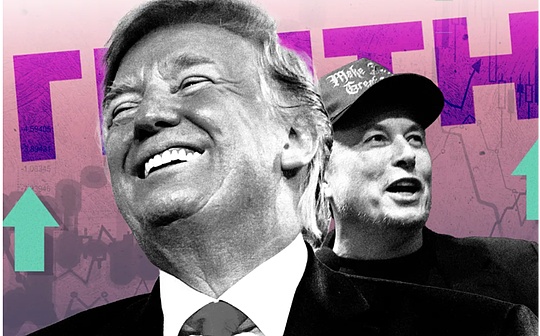
 jinse
jinse